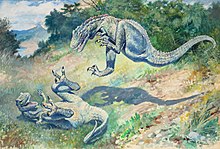Dryptosaurus
| Dryptosaurus | ||||||||||||
|---|---|---|---|---|---|---|---|---|---|---|---|---|

Live reconstruction of Dryptosaurus |
||||||||||||
| Temporal occurrence | ||||||||||||
| Upper Cretaceous (late Campanium to early Maastrichtian ) | ||||||||||||
| 76.4 to 69.9 million years | ||||||||||||
| Locations | ||||||||||||
|
||||||||||||
| Systematics | ||||||||||||
|
||||||||||||
| Scientific name | ||||||||||||
| Dryptosaurus | ||||||||||||
| Marsh , 1877 | ||||||||||||
| Art | ||||||||||||
|
Dryptosaurus ("rending lizard") was a medium-sized theropod dinosaur from the late Upper Cretaceous (upper Campanium to lower Maastrichtian) of North America. The genus is assigned to the Tyrannosauroidea and contains only the type species D. aquilunguis . Dryptosaurus was the first carnivore among the first dinosaurs to be found in North America.
description
Dryptosaurus was about six meters long and had strong, clawed arms and blade-shaped teeth curved backwards. The shinbone (tibia) was longer than the thighbone (femur), which enabled him to run fast. The distinguishing feature was a huge claw on the first finger, which is 21 centimeters long (excluding the horn sheath in living animals) and about 75 percent of the length of the upper arm bone (humerus). Some scientists suspected that this claw, which was initially believed to belong to one of the toes, severed the prey's veins or pried open the armor of ankylosaurs .
Historical
After Hadrosaurus foulkii, Dryptosaurus was the second almost complete skeleton find of a dinosaur and the first of a predatory dinosaur (previously only teeth were known). It was found in 1863 by Edward Drinker Cope in the marl pits near Haddonfield in New Jersey , the same area in which Hadrosaurus foulkii was discovered in 1838, the discovery of which Joseph Leidy became aware of in 1858 . In 1868 Othniel Charles Marsh also came to Haddonfield and here the Bone Wars between Cope and Marsh began, because after Cope had introduced Marsh to the marl pit owners in Haddonfield, he discovered that he had secretly returned later and paid the workers and mine owners money for Fossils bot. In contrast to Hadrosaurus foulkii , Dryptosaurus was only temporarily installed in the museum, but reconstruction drawings by Charles R. Knight made it known.
Cope chose the name Laelaps aquilunguis for this dinosaur in 1866 , after a hunting dog Laelaps des Aktaion from Greek mythology, from which no animal escaped. But this name was already assigned to a genus of mites and therefore had to be changed ( priority rule ). Ironically, Cope's ore competitor Marsh named him Dryptosaurus in 1877 .
When Dryptosaurus was discovered, it was believed to be the most formidable predator of all time, and it was believed that it jumped kangaroo-like at its preferred prey, the duck-billed Hadrosaurus , to ram its long claws into its flesh. A number of dinosaur species have been assigned to Dryptosaurus , such as Allosaurus medius and Creosaurus potens , but only the type species is recognized.
literature
Mainly used:
- Don Lessem , Donald F. Glut : The Dinosaur Society's Dinosaur Encyclopedia. Random House, New York 1993, ISBN 0-679-41770-2 , pp. 164-165.
Individual evidence
- ^ Gregory S. Paul: The Princeton Field Guide To Dinosaurs , 2010. ISBN 978-0-691-13720-9 , p. 100 online
- ^ Dinosaurs of South Jersey
- ^ Haddonfield and the Bone Wars
- ↑ By Waterhouse Hopkins at the Philadelphia Academy. Efforts are being made to reassemble it. Interview with Ken Carpenter
